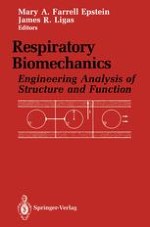1990 | OriginalPaper | Buchkapitel
Respiratory Fluid Mechanics and Transport
verfasst von : Mary A. Farrell Epstein
Erschienen in: Respiratory Biomechanics
Verlag: Springer New York
Enthalten in: Professional Book Archive
Aktivieren Sie unsere intelligente Suche, um passende Fachinhalte oder Patente zu finden.
Wählen Sie Textabschnitte aus um mit Künstlicher Intelligenz passenden Patente zu finden. powered by
Markieren Sie Textabschnitte, um KI-gestützt weitere passende Inhalte zu finden. powered by
The last decade was a period of significant progress in our understanding of gas phase fluid mechanics and species or mass transport in the airways. Several factors contributed to this advance. Detailed measurements of airway geometry from the nasal passages to the alveolar level, made possible by advances in computer-based imaging and microscopy systems, revealed the complex geometry in which gas flow and mass transport take place, even in normal lungs. Introduction of high-frequency ventilation (HFV) techniques with frequencies of 20 or more times resting breathing rates underscored the sensitivity of pressure gradients and velocity distributions to subtle changes in airway geometry and mechanical properties, and focused attention on mechanisms for mass transport under these conditions. The need to understand factors affecting gas exchange at elevated frequencies reopened questions of the interaction of respiratory mechanics with gas exchange. A third factor was the ready availability of computational resources through introduction of the microcomputer, and the continued enhancement of execution speed, memory and storage in medium and large-scale computer systems. These permitted extensive investigation of nonlinear parameter estimation techniques and complex computer simulations as innovative approaches for data analysis.
